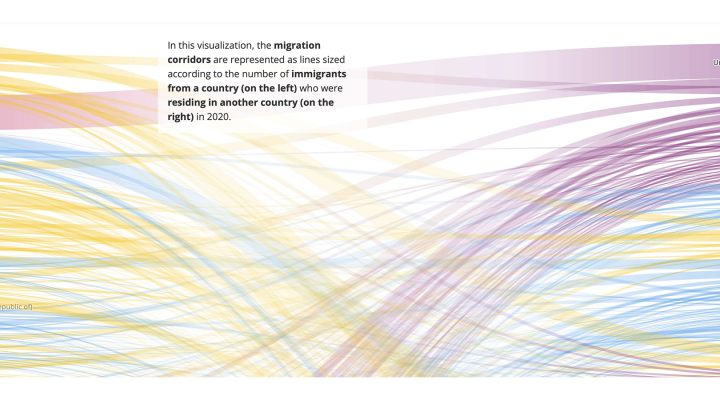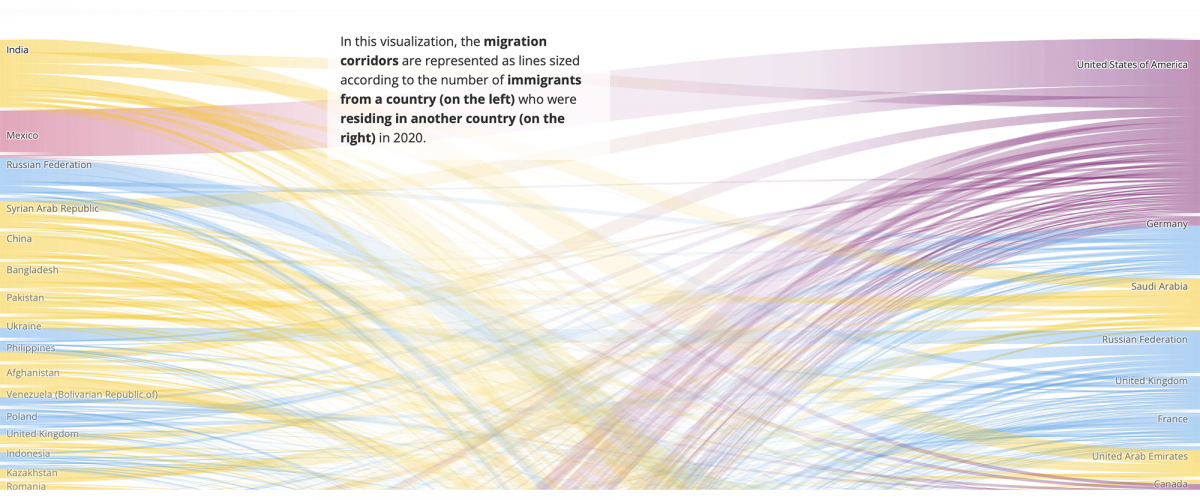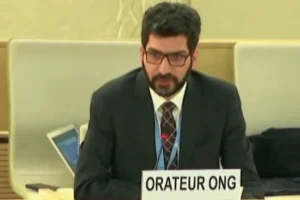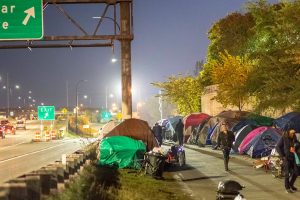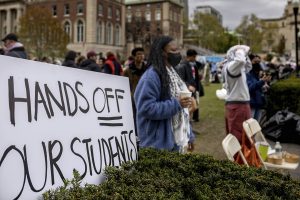When it comes to discussing the issue of global migration, most Americans speak with certainty of their views as though they had been briefed by the United Nations.
Yet what passes as conventional wisdom in the United States often doesn’t square with documented reality around the world.
For starters, global migration is not a uniquely American problem. While the U.S. is the destination of more migrants than any other single country, the regional perspective is different. Europe and Asia far outpace North America as the home of immigrants today.
Because the U.S is such a vast land — both geographically and by population — compared to most of the world’s nations, raw numbers alone do not tell the full story. When immigrants are seen as a percentage of total population, a different image emerges.
The global perspective
In 2020, the U.S. was home to nearly 51 million migrants, according to Pew Research. In raw numbers, that’s the largest of any nation by a wide margin. The next-largest migrant population is found in Germany, where 15.8 million foreign-born people lived in 2020.
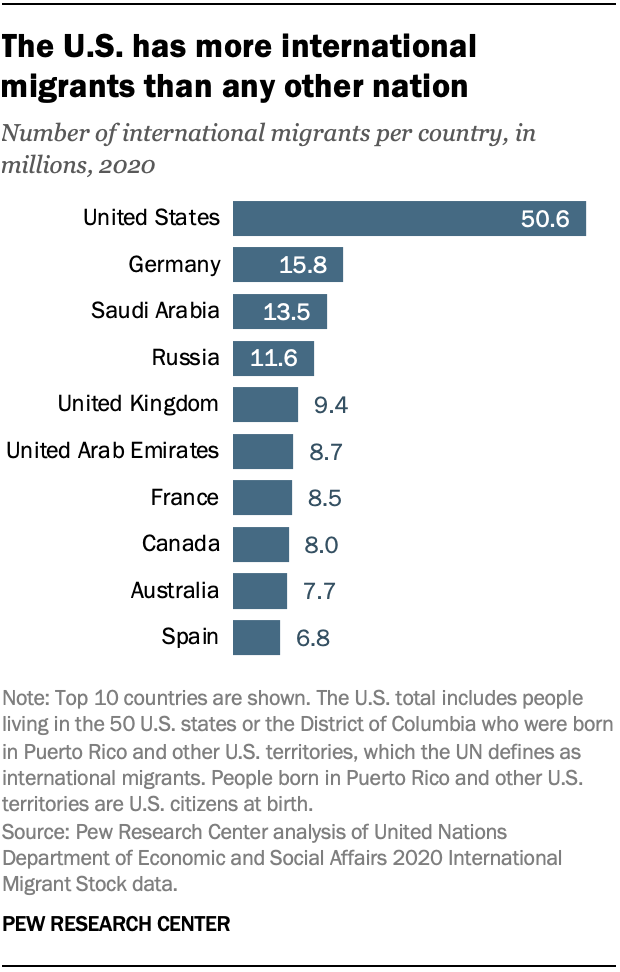 But the total population of the U.S. in 2020 was 330 million — meaning migrants accounted for 15% of the population. By comparison, Germany’s total population in 2020 was 83 million, meaning migrants accounted for 19% of the population there.
But the total population of the U.S. in 2020 was 330 million — meaning migrants accounted for 15% of the population. By comparison, Germany’s total population in 2020 was 83 million, meaning migrants accounted for 19% of the population there.
Pew explained: “The countries that have the most international migrants are generally not the same countries where international migrants make up the greatest share of the population.”
The percentage of the U.S. population made up of migrants is smaller than in 24 other countries with populations of 1 million or more, Pew noted.
It would no doubt surprise most Americans to learn that “the Middle East accounts for most of the top 10 countries when looking at the migrant share of the population,” as Pew documents. “In 2020, 93.9% of all people living in the United Arab Emirates were international migrants, followed by 80.6% of people in Qatar and 71.3% of people in Kuwait. Other Middle Eastern countries among the top 10 include Bahrain, Oman, Saudi Arabia, Jordan and Lebanon.”
Talk of America being “invaded” by migrants pales in comparison to these Middle East countries.
Continental perspectives
And while the U.S. is home to the largest number of migrants, North America is not. That title goes to Europe and Asia.
Pew reports an estimated 86.7 million international migrants lived in Europe in 2020 and 85.6 million in Asia: “The number of international migrants living in these two regions has steadily increased since 2005.”
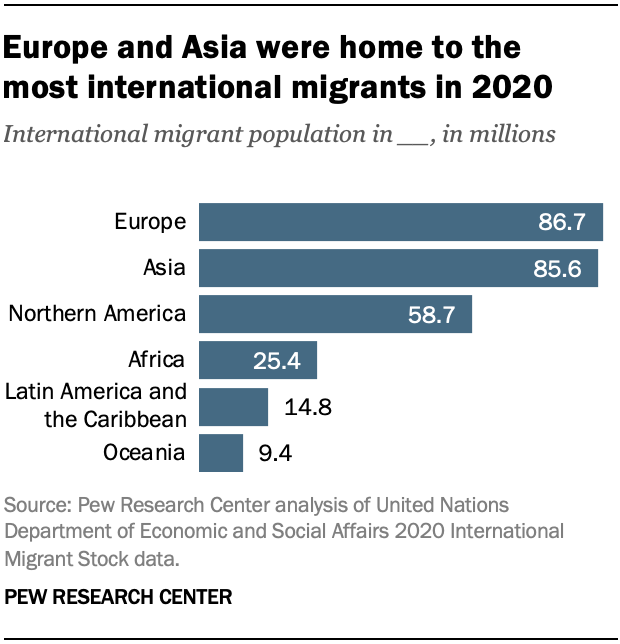 Nor does North America have the fastest-growing migrant population. That title goes to Latin America and the Caribbean, where the international migrant population has doubled since 2005.
Nor does North America have the fastest-growing migrant population. That title goes to Latin America and the Caribbean, where the international migrant population has doubled since 2005.
North America also does not hold the record for the largest share of migrants as a percentage of population. That title goes to Oceania, which includes Australia, New Zealand and several Pacific island nations and territories. In 2020, 21.4% of all residents in Oceania were international migrants.
Highest desire to migrate in a decade
Globally, people’s desire to migrate is at its highest point in a decade, according to Gallup.
Although the COVID-19 pandemic disrupted global migration, the previous trend accelerated in 2021, the polling firm found.
In that year, “16% of adults worldwide — which projects to almost 900 million people — said they would like to leave their own country permanently, if they could,” Gallup reported.
That’s 900 million people who would migrate somewhere else if they could. Gallup’s data are based on interviews with 127,000 adults in 122 countries.
According to the United Nations, international migration dropped by about 27% from mid-2019 to mid-2020, thanks to the pandemic.
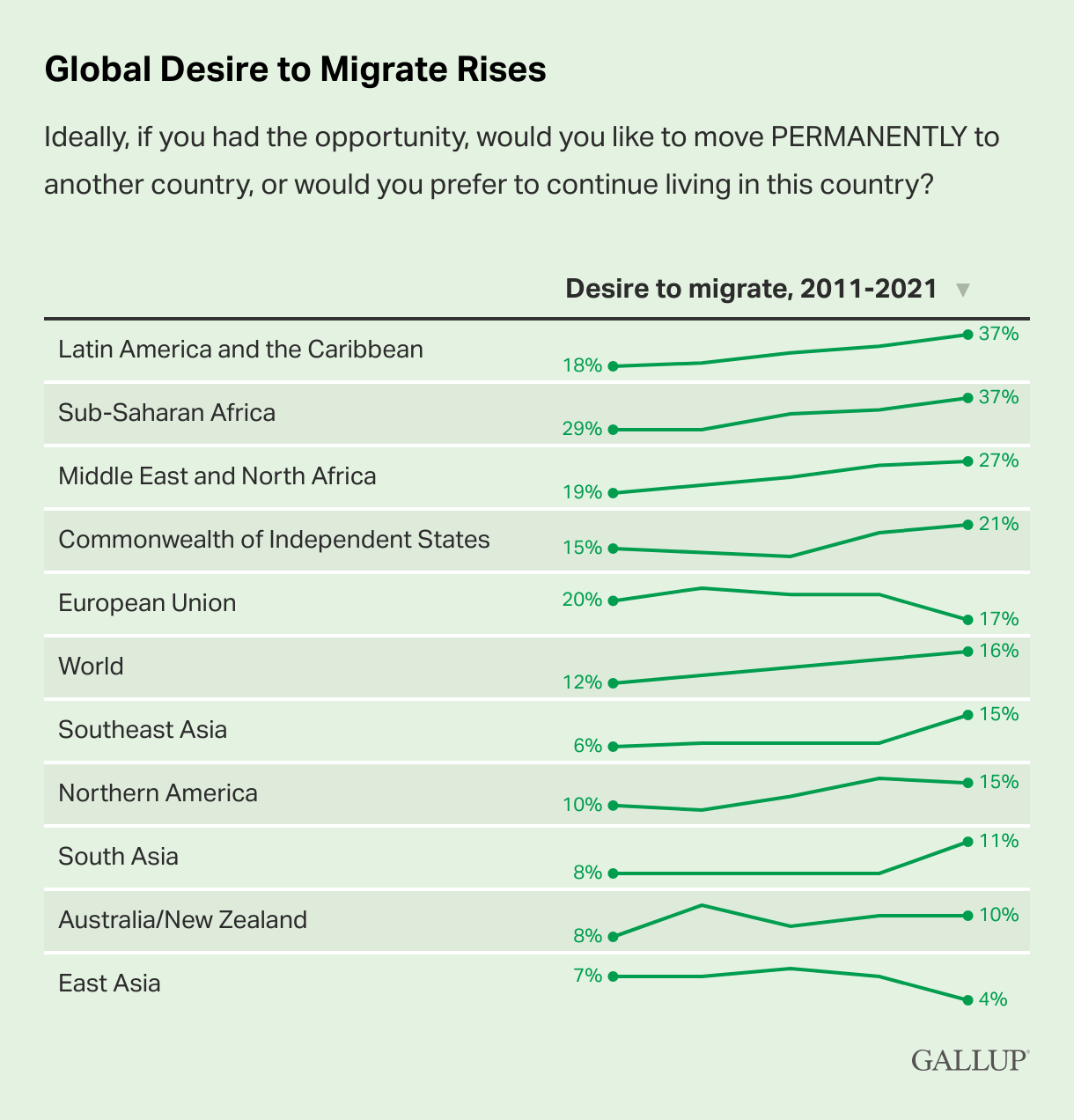
But now, “in many parts of the world, people’s desire is higher than it has been in a decade,” Gallup noted. “Desire to migrate rose to decade-high levels in regions that are already well-known for sending migrants, such as Latin America and the Caribbean, sub-Saharan Africa, Southeast Asia, South Asia, and the Commonwealth of Independent States.”
Gallup found 13 countries where about half or more of the adult population “would like to move to another country if they had the chance. These countries represent nearly every region of the world — except for Northern America and the EU. Many of these countries have consistently shown up on this list year after year.”
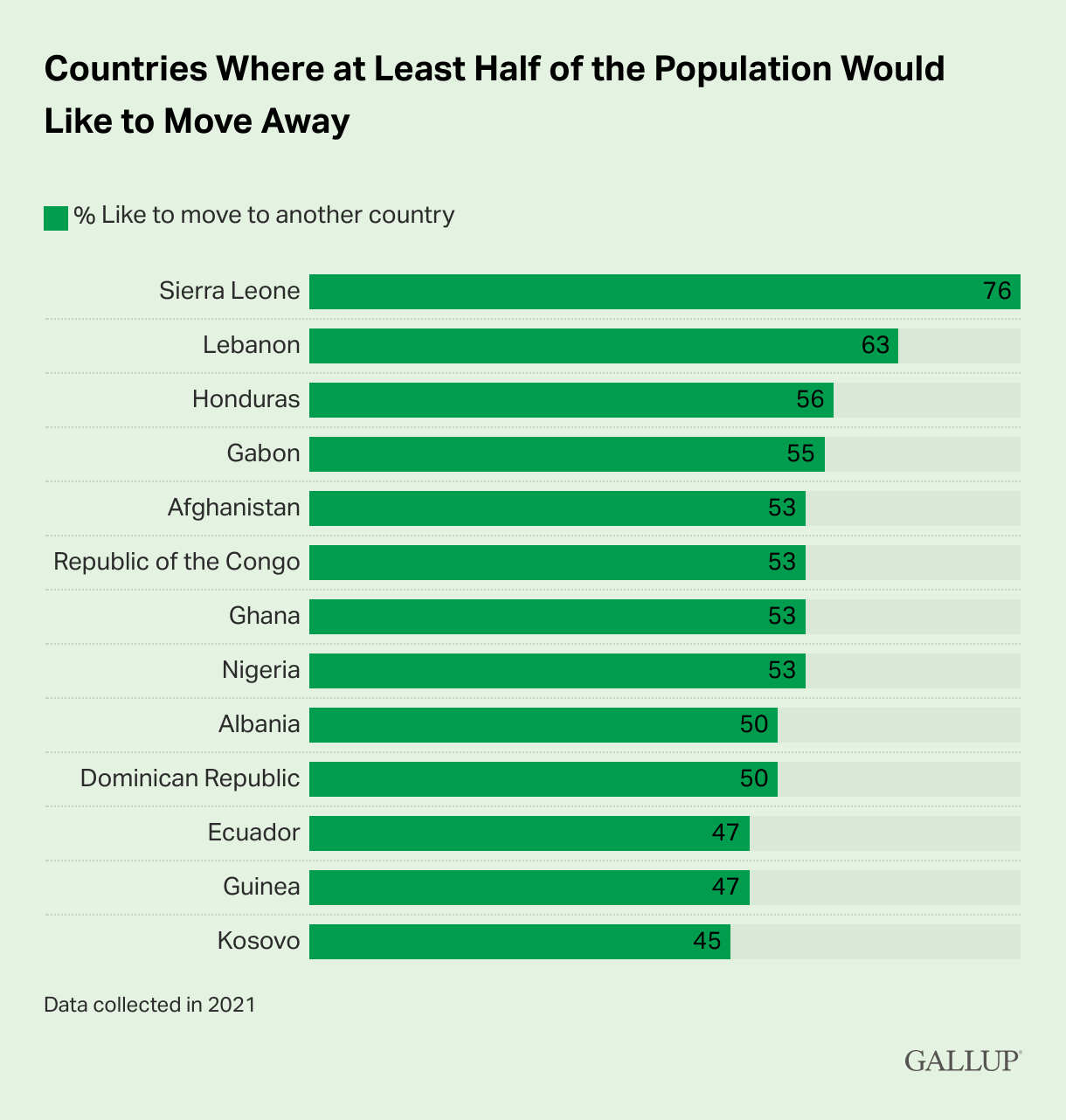 These migration hotspots include Lebanon, where 63% of residents said they would leave if they could, and Sierra Leone, where 76% of people wish they could migrate. Other top countries for those desiring to leave include Honduras (56%), Gabon (55%), Afghanistan (53%), Democratic Republic of Congo, Ghana and Nigeria (all 53%).
These migration hotspots include Lebanon, where 63% of residents said they would leave if they could, and Sierra Leone, where 76% of people wish they could migrate. Other top countries for those desiring to leave include Honduras (56%), Gabon (55%), Afghanistan (53%), Democratic Republic of Congo, Ghana and Nigeria (all 53%).
Most-desired destinations
Americans often assume all the world’s migrants want to come to the United States, but that’s not true. While the U.S. remains the most-desired destination, it is less attractive today than before, Gallup found.
For the 15 years Gallup has tracked this data, the U.S. has topped the list of preferred migrant destinations.
Over the past decade, the U.S. has dropped from 22% to 18% as the preferred destination for migrants. But even though one-fifth of the world’s migrants would like to come to the U.S., that means four-fifths want to go somewhere else.
Canada is a new hot spot where about 8% of potential migrants would like to go, Gallup found. Other most-desired destinations include Germany, France, the UK, Australia, Japan and Italy.
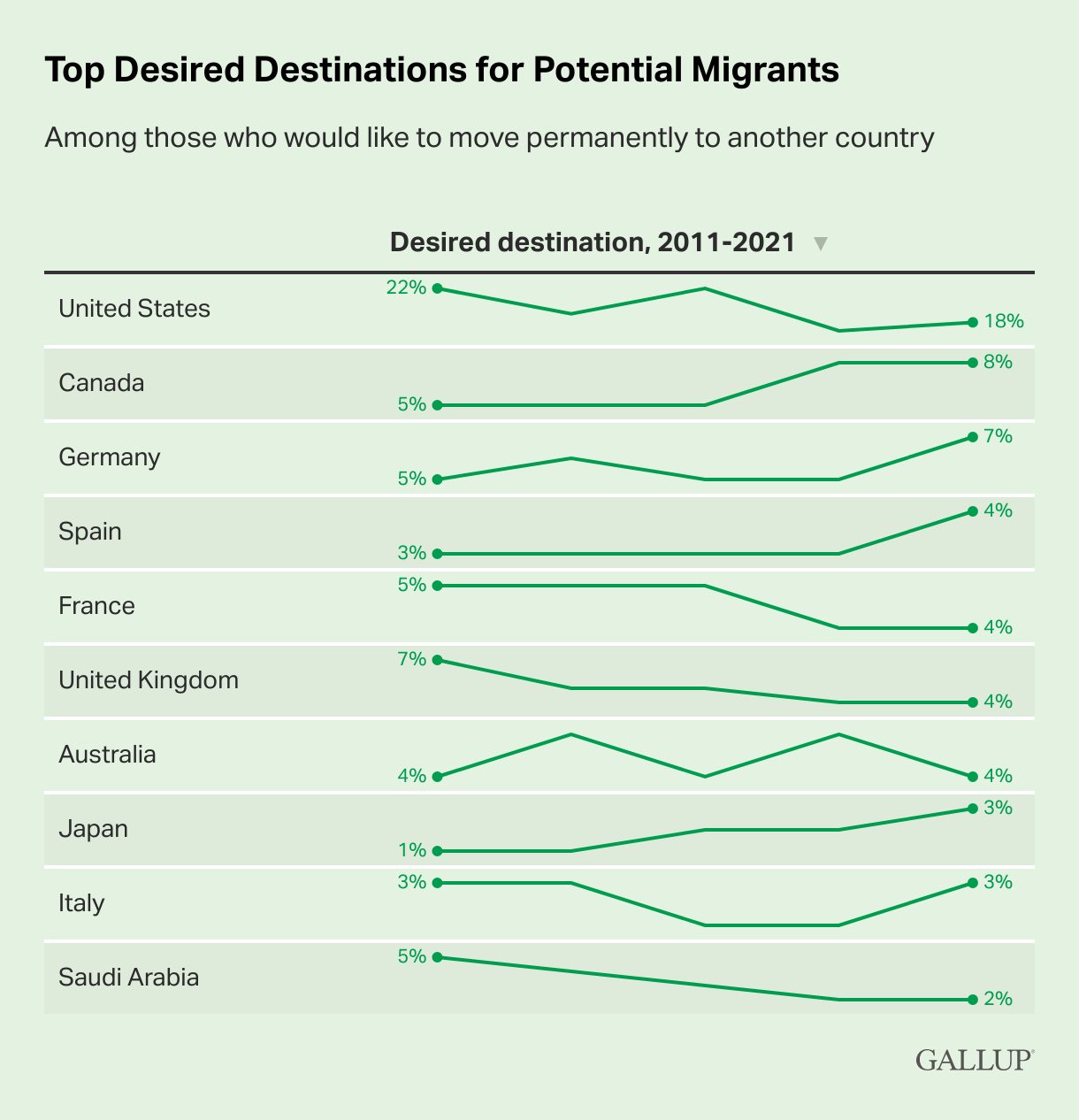 What do these countries have in common? Democratic forms of government and stable economies.
What do these countries have in common? Democratic forms of government and stable economies.
Some of these nations — particularly Germany, France and Italy — have been inundated with migrants in recent years, especially in relation to the size of their populations and land.
In Italy, reality and perception diverge greatly. An Italian media outlet reported one poll found Italians believe 25% of the nation’s population is now immigrants. The reality is about 8%.
Italy’s newly elected prime minister, Giorgia Meloni, is known as a vocal opponent of immigration. She has called the nation’s immigration policies overly lenient and said they risk turning the country into the “refugee camp of Europe.”
Currently, about 10% of Italy’s population could be considered immigrants.
France also stands among the European countries most in conflict about immigrants. There, some of the same forces at play in the U.S. and with Trumpism continue to play out.
Although the overall percentage of population in France that is foreign-born is similar to the U.S., the immigration population there is largely concentrated in the Paris region. By some accounts, as much as 45% of the region’s population is foreign-born or born to foreign-born parents.
“To far-right parties such as (Marine) Le Pen’s National Rally, immigration represents a threat to French identity and security, as well as a huge economic and social cost, to which the government should respond by closing its borders,” according to Ekrame Boubtane, writing for the Migration Policy Institute.
And there is a religious angle to this story there as in the U.S., he adds. “Immigration and integration issues have often been conflated with religion, notably since the latter half of the 20th century, when many Muslim immigrants arrived from former colonies in North Africa and posed what some interpreted as a challenge to France’s avowedly secular national identity.”
Yet in other places, migrants are welcome as an answer to an aging population. For example, Canada plans to take in nearly 1.5 million more migrants by 2025 to offset its aging population and ease labor shortages, Gallup reported.
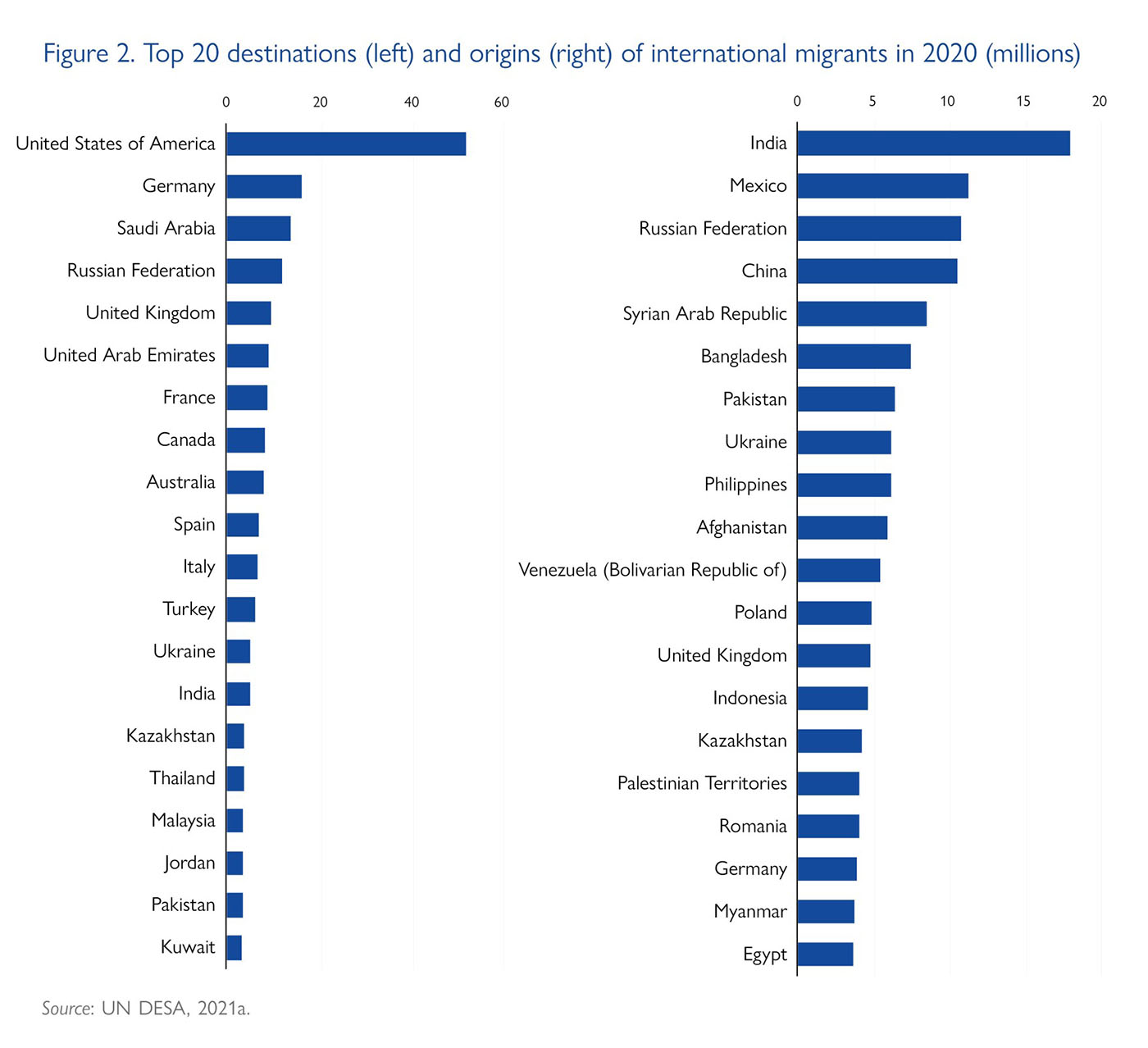
Increasing global migration
All this comes in an era of the greatest global migration in history.
“Today, more people than ever live in a country other than the one in which they were born,” according to the United Nations.
“The number of international migrants grew to 281 million in 2020, meaning that 3.6% of the world’s people lived outside their country of birth that year,” Pew reported.
Pew Trusts — a distinct organization from Pew Research — adds to the story: “Today, more people worldwide live outside their birth countries than ever before — 244 million in 2015, triple the total in 1960. To put that in perspective, if international migrants were a nation of their own, they would make up the world’s fifth-largest country, just behind Indonesia in terms of population.”
War, violence and famine
A major driver in global migration is conflict, war and natural disaster — some caused by global warming, some caused by dictators, some caused by famine, some caused by out-of-control violence.
Amid the world’s migrants, 89.4 million were considered “displaced people, according to Pew Trusts. That’s a new high.
“Overall, the number of displaced persons rose from 84.8 million in 2019 to 89.4 million in 2020, according to the UN’s World Migration Report 2022. Overall, about 1.1% of the world’s population are displaced people,” Pew Trusts reported.
War remains a reliable instigator of global migration.
Russia’s recent invasion of Ukraine, for example, has scattered 8 million asylum seekers across Europe, according to the United Nations. Whether those refugees will become long-term residents (immigrants) of their host nations or merely temporary migrants remains to be seen.
“Deadly conflict, above all, is driving the massive exodus of refugees.”
“Deadly conflict, above all, is driving the massive exodus of refugees. Wars in Afghanistan, Somalia, and Syria alone are responsible for more than half of the world’s refugee population,” according to Jean-Marie Guéhenno of the International Crisis Group. “Forty million people — two-thirds of the world’s forcibly displaced — are displaced within their own countries by conflict and violence.”
One change contributing to this is that civilians are more vulnerable in war today, he explained. “In today’s wars, civilians are also targeted with impunity by the fighting parties, and international humanitarian norms to protect civilians are routinely violated.”
And a refugee crisis sparked by war, he said, “is a long one. As of early 2014, the average time a person spends as a refugee stood at a record 17 years, while the rate of those returning home was the lowest in decades.”
This also helps explain why it is so difficult for Americans to comprehend the flow of migrants from Central America.
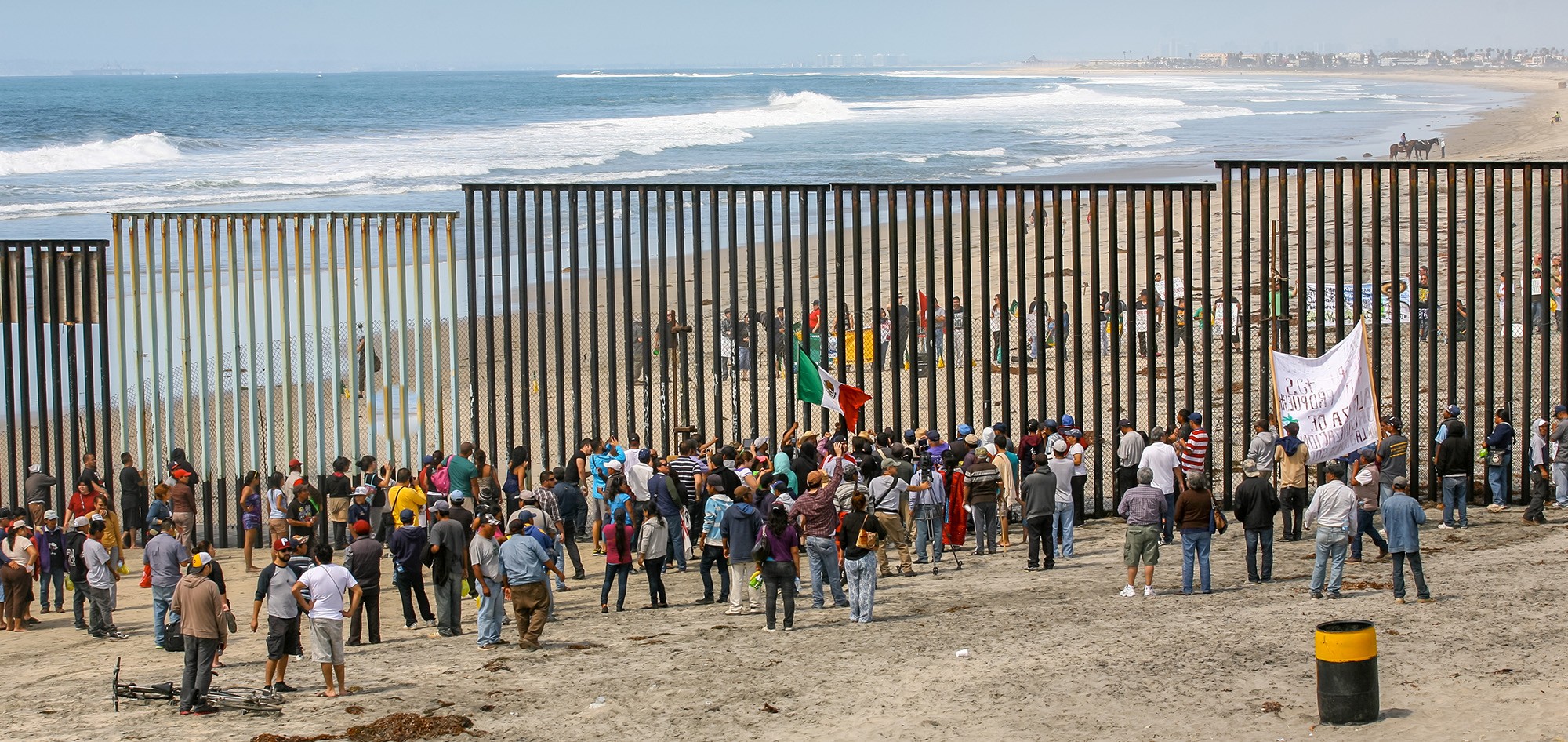
Migrants and workers gather on both sides of the iron and steel wall that separates the border between Mexico and the United States in Playas de Tijuana. (Getty Images)
“It is an outdated notion that people from El Salvador, Guatemala and Honduras are primarily looking for economic opportunity in the United States and, therefore, should wait in line for a visa. For people fleeing these countries, waiting for a visa can result in death, rape, or forcible recruitment into crime,” according to Sarah Bermeo, professor of public policy and political science at Duke University.
In an article for the Brookings Institution, she explained: “A recent report from Doctors Without Borders states that these Northern Triangle countries are experiencing ‘unprecedented levels of violence outside a war zone’ and that ‘citizens are murdered with impunity, kidnappings and extortion are daily occurrences. Non-state actors perpetuate insecurity and forcibly recruit individuals into their ranks and use sexual violence as a tool of intimidation and control.’”
She added: “There have always been migrants — documented and undocumented — crossing the U.S. southern border. Many of them come for economic reasons. But the current flow is different. In 2016, 42% of people apprehended at the U.S. southern border came from Northern Triangle countries, compared to 13% in 2010. While economic incentives are still a push factor, the United States Conference of Catholic Bishops concludes that generalized violence ‘has played a decisive and forceful role’ for recent arrivals.’”
Around the globe — but particularly in regions of Africa — conflict and global warming are creating a one-two punch that compels global migration.
“The links between conflict and hunger are clear. For civilians living in a conflict zone, conflict is not only a threat to their lives, but also their livelihoods,” according to Laura Hammond of SOAS University of London, writing for Concern Worldwide. “Lost wages mean they’re unable to provide for their most basic needs, including food. If the situation is bad enough, and if a person is lucky enough to get out, they will flee to safety.”
She added: “Hunger is consistently a cause and consequence of forced migration in other instances. Some of the harshest effects of climate change are felt in countries where the main economy is agriculture, and droughts and floods have the same devastating effect on livelihoods in these areas. Even a natural disaster not driven by the climate crisis, like an earthquake, could lead to a family uprooting their lives if the circumstances are dire enough.”
Staying close to home
This, in turn, explains another often-overlooked factor of global migration. Most migrants don’t cross the globe. Instead, most migrate within the region where they began.
“A majority of the world’s international migrants lived within their region of origin in 2020,” Pew Research reported. “While some migrants may go to new regions of the world, a majority (54.9%) lived within their region of origin in 2020. However, international migration within regions still varies widely. For example, 69.9% of Europe’s international migrants resided in another European country in 2020, reflecting migration out of Eastern European countries such as Russia, Ukraine, Poland and Romania to Western European ones.”
Further, “migrants from Africa are about as likely to live within Africa as they are to live outside of the continent (51.6% vs. 48.4%).”
Not surprisingly, migrants from Latin America and the Caribbean, as well as the Northern America region, are the least likely to live within their region of origin, Pew added. That relates to a large portion of the influx of migrants to the U.S. today, many of whom journey across multiple countries to get to the U.S. through Mexico.
Top sources of global migration
Despite the reality of people displaced by war, violence and famine, other factors also contribute to migration. Take India, for example.
India is the top country of origin for the world’s migrants, according to Pew Research, and has been a large source of international migrants for more than a century. “In 2020, 17.9 million international migrants traced their origins back to India, followed by Mexico with about 11.2 million and Russia with about 10.8 million.”
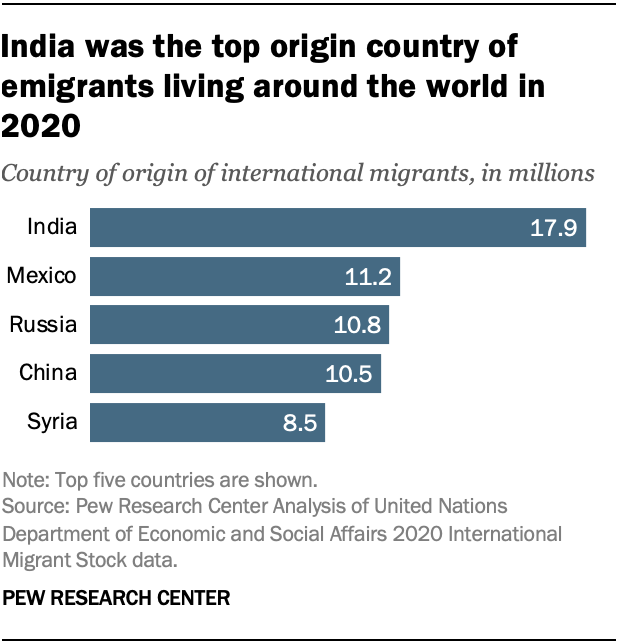 India’s migrants “are dispersed around the world, but the countries with the largest Indian migrant populations are the United Arab Emirates (3.5 million), the U.S. (2.7 million) and Saudi Arabia (2.5 million),” Pew reported.
India’s migrants “are dispersed around the world, but the countries with the largest Indian migrant populations are the United Arab Emirates (3.5 million), the U.S. (2.7 million) and Saudi Arabia (2.5 million),” Pew reported.
Although India does not fit the profile of the countries most often considered sources of migration, its sheer size makes it a contender. India is the world’s second-largest country, with a population of 1.4 billion in 2020.
Its history as both a source of migrants and a recipient of migrants is well-established, according to the Migration Policy Institute.
“The massive India diaspora, which can be found across the globe, includes millions of descendants of migrants and has taken shape mostly since the start of the colonial era, when large numbers of Indians were forcibly relocated to work on plantations and construction projects,” the institute reports. “The 1833 abolition of slavery in most parts of the British Empire transformed the colonial system, replacing slavery with indentured servitude. In the eight decades that followed, the United Kingdom relocated millions of bonded Indian workers to colonies across Africa, Asia, and the Caribbean. Later, India’s 1947 partition with Pakistan prompted the movement of millions of migrants throughout South Asia, in a vast reshuffling carried out along religious, ethnic and other lines.”
And that trend continues today for a host of reasons.
Migration pathways
Patterns of migration can be charted to create visual representations of the most common pathways. One example of this is viewable on a United Nations migration website.
Distinct patterns of migrant “corridors” are found not only in the Americas but also in Europe and Asia.
These corridors are both old and new, according to the World Economic Forum.
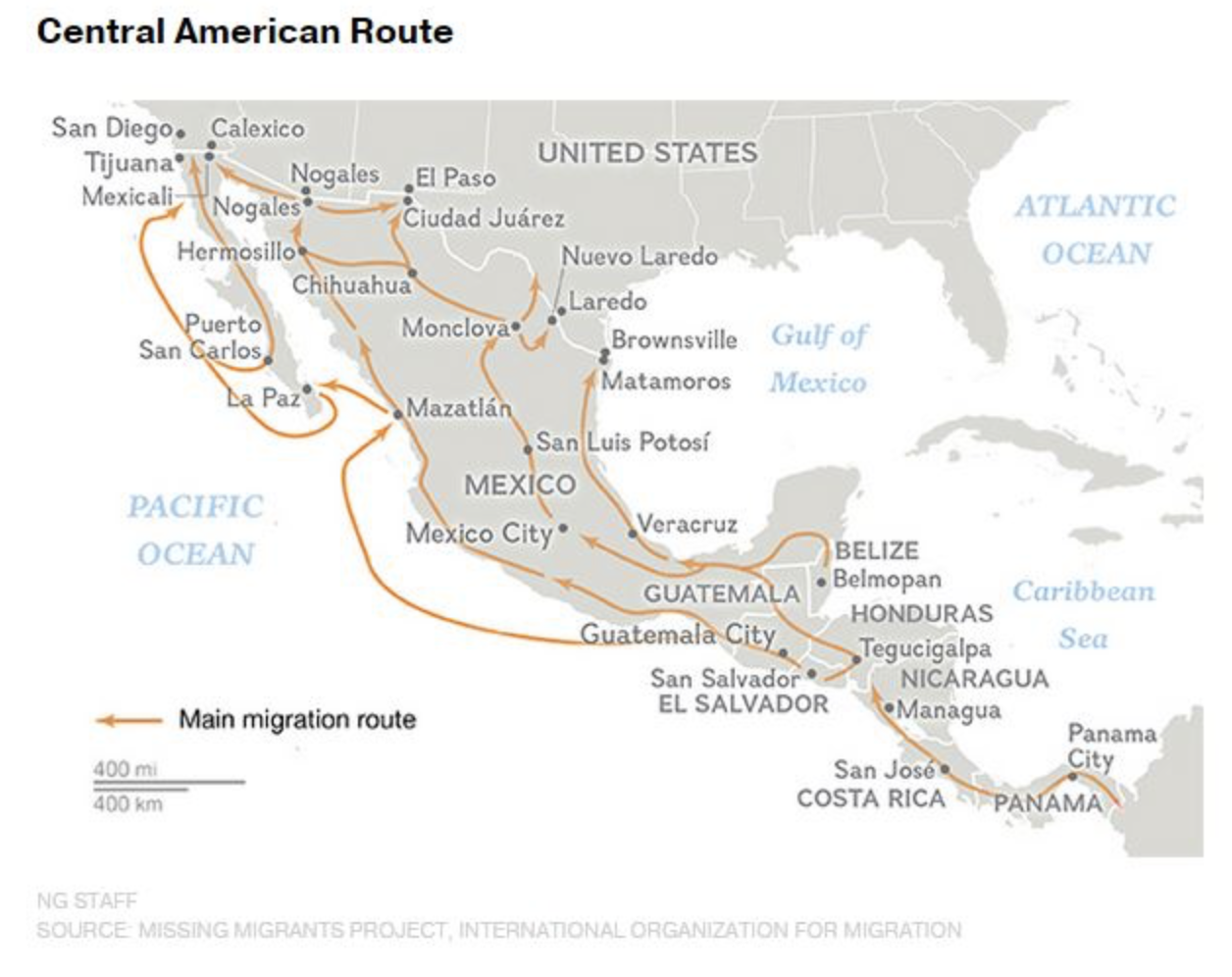 “The largest migration corridor in the world (Mexico to the United States) did not emerge recently. Contrary to popular media and political representations, Mexican emigration to the United States has occurred over many decades,” the group explained. “But the second-largest corridor in the world, Syria to Turkey, has developed only recently. The conflict in Syria has resulted in mass displacement, forcing millions of Syrians to leave their country. An estimated 3.7 million Syrians were residing in Turkey in 2019.
“The largest migration corridor in the world (Mexico to the United States) did not emerge recently. Contrary to popular media and political representations, Mexican emigration to the United States has occurred over many decades,” the group explained. “But the second-largest corridor in the world, Syria to Turkey, has developed only recently. The conflict in Syria has resulted in mass displacement, forcing millions of Syrians to leave their country. An estimated 3.7 million Syrians were residing in Turkey in 2019.
“Meanwhile, other large corridors, such as the one between India and Pakistan, are partly due to historical events such as the mass displacement during the 1947 partition.”
Why does this matter?
In the U.S. as well as in parts of Europe, anti-immigrant forces continue to spin tales that simply are not true. These scare tactics almost always omit the global perspective. Instead, they focus on the perceived “threat” immigrants pose to that country.
Recent anti-immigrant rhetoric in America has focused almost exclusively on the southern border and largely on Mexican immigrants. While the data show the flow of Mexican nationals across the southern border is indeed common, most “America First” speeches fail to address the causes of that migration or its connection to world events.
The U.S. is not unique in facing challenges related to migration and immigration. We Americans simply assume we are unique — a very American trait.
Context matters.
Mark Wingfield serves as executive director and publisher of Baptist News Global.
Related articles:
Ecumenical network seeks to address causes of migration at the source
Scholar explores the ways migration changes people’s attitudes, beliefs and religion

